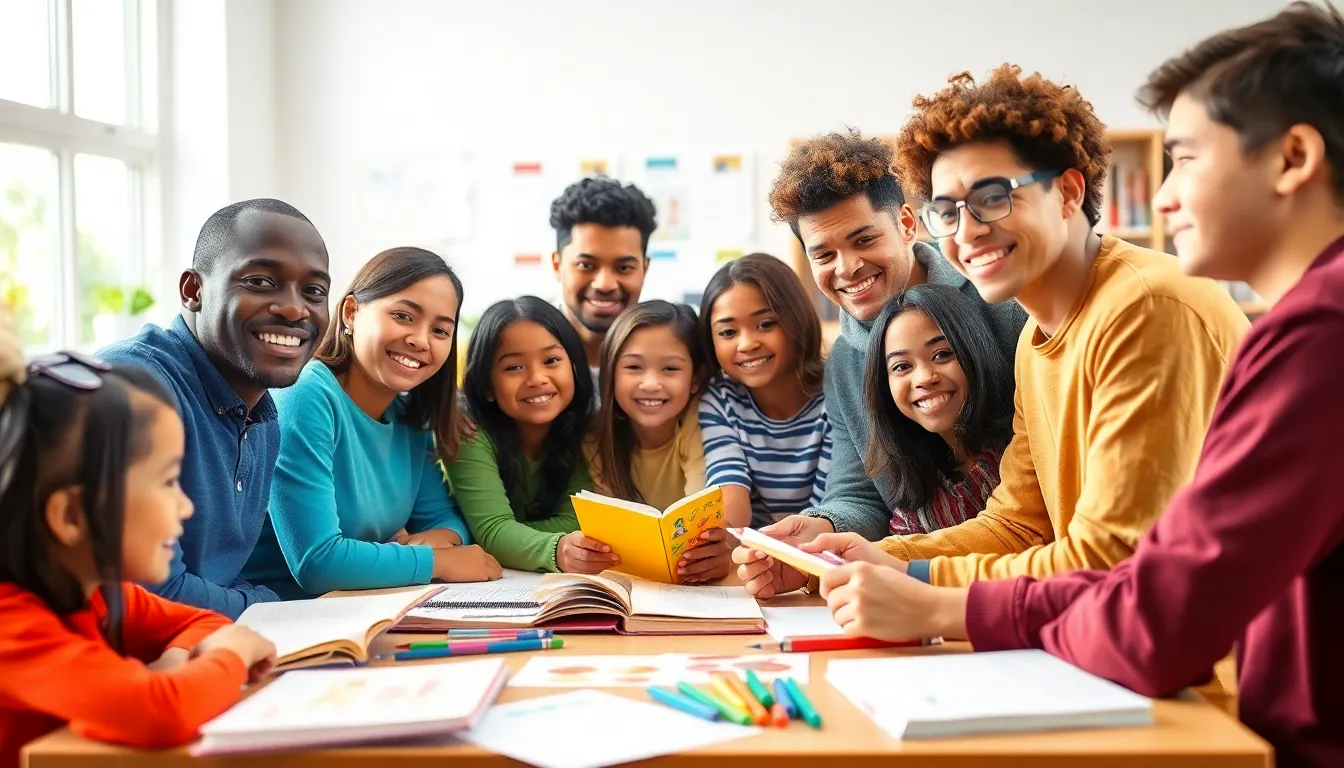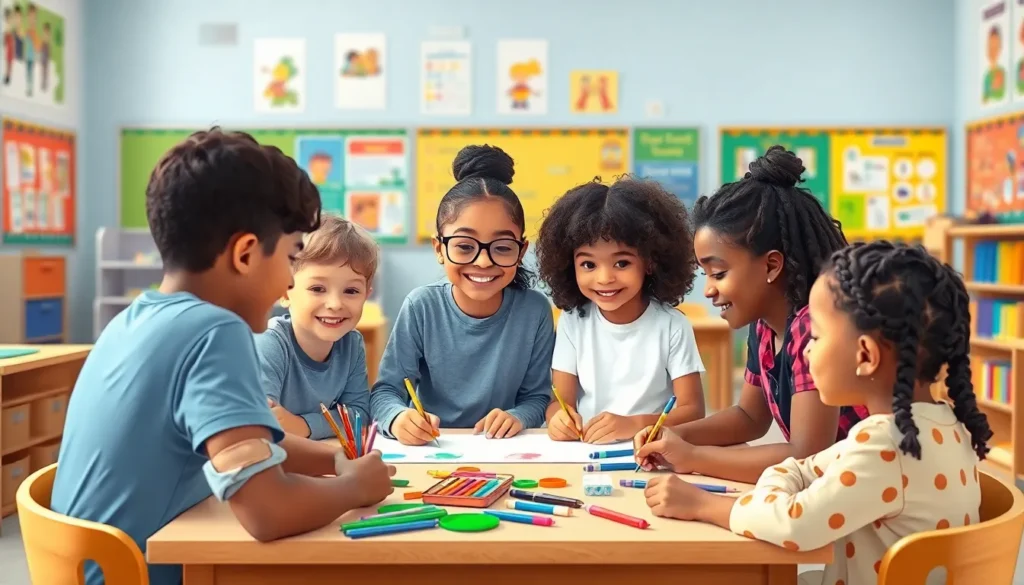Table of Contents
ToggleImagine a classroom where every student feels like a superstar, regardless of their unique challenges. Inclusive education isn’t just a buzzword; it’s a game-changer that transforms traditional learning environments into vibrant hubs of diversity and creativity. It’s about more than just sharing crayons; it’s about embracing differences and unlocking the full potential of every learner.
Understanding Inclusive Education
Inclusive education transforms traditional learning environments. It creates spaces where every student feels valued and empowered, regardless of individual challenges.
Definition of Inclusive Education
Inclusive education refers to educational practices that ensure all students, including those with diverse needs, participate in general education settings. This approach fosters acceptance and values diversity, aiming to provide equal opportunities for learning. Models emphasize collaboration among educators, support staff, and families to address students’ unique requirements. Implementing inclusive education promotes belonging, where every student’s voice contributes to the classroom dynamics.
Historical Context
Historically, educational systems often segregated students with disabilities or special needs from their peers. The shift toward inclusive education gained momentum in the late 20th century, driven by social movements advocating for human rights. Legislation, such as the Individuals with Disabilities Education Act (IDEA) in 1975, marked a significant change. This act mandated that students with disabilities receive free appropriate public education in the least restrictive environment. Over time, this historical evolution laid the groundwork for current inclusive practices, emphasizing equitable access and participation in education for all individuals.
Benefits of Inclusive Education

Inclusive education offers numerous advantages that contribute to a more equitable learning environment. The approach nurtures the whole child, ensuring that each student thrives academically and socially.
Academic Advantages
Inclusive education leads to improved academic outcomes for all students. Research shows that students with disabilities who learn alongside their peers achieve higher grades and better standardized test scores. General education students experience enhanced problem-solving skills and greater overall understanding of diverse perspectives. Collaborative learning settings foster critical thinking and creativity, allowing students to engage meaningfully with their curriculum. Such environments challenge every learner to perform at their best.
Social and Emotional Growth
Social and emotional growth flourishes within inclusive classrooms. Students develop essential interpersonal skills, benefiting from interactions with classmates from various backgrounds. They learn empathy and respect through cooperative activities that promote teamwork. This exposure reduces bullying and fosters a sense of belonging, contributing to increased self-esteem among all students. Emotional resilience often improves as learners navigate challenges together, equipping them with skills for future success.
Challenges in Implementing Inclusive Education
Several challenges arise in the implementation of inclusive education, impacting its effectiveness and reach.
Resource Allocation
Resource allocation often presents significant hurdles for schools embracing inclusive education. Funding disparities frequently lead to insufficient resources for specialized programs and support staff. Many schools struggle to provide necessary tools such as assistive technology and adaptive materials. Consequently, students with diverse needs may not receive adequate support, hindering their educational experience. Limited access to physical spaces and learning materials can further exacerbate these issues. Schools must prioritize funding to ensure all students, regardless of their challenges, can thrive in an inclusive environment.
Teacher Training
Teacher training remains a critical component in the successful implementation of inclusive education. Many educators lack the proper training to effectively teach students with diverse needs. Professional development opportunities often fail to address the specific strategies necessary for managing inclusive classrooms. Furthermore, teachers may not feel confident in their ability to adapt lessons or assessments for all learners. Implementing targeted training programs can enhance educators’ skills and ensure they are better equipped to foster inclusive learning environments. Schools should emphasize ongoing professional development to build competencies in inclusive practices and support teachers in meeting the needs of every student.
Strategies for Successful Inclusive Education
Inclusive education thrives on effective strategies that enable all students to succeed. Collaboration and individualized support play crucial roles in creating an equitable learning environment.
Collaborative Teaching Approaches
Using collaborative teaching approaches enhances the inclusivity of classrooms. Co-teaching models, like the one-teach, one-support method, allow a general education teacher and a special education teacher to work together. They share responsibilities, ensuring personalized attention. Diverse instructional strategies help meet varying needs within the same lesson, fostering engagement among all students. By encouraging peer interactions, students develop interpersonal skills and mutual respect. Moreover, both teachers learn from one another, ultimately improving their professional practices.
Individualized Education Plans (IEPs)
Individualized Education Plans (IEPs) serve as vital tools for supporting students with unique learning needs. Each IEP outlines specific goals tailored to the student’s strengths and challenges. Collaboration among teachers, parents, and specialists ensures that all aspects of the student’s education are addressed. Continuous assessment and adjustment of these plans guarantee progress toward established goals. Providing accommodations and modifications helps create a supportive learning environment. Involving students in their IEP discussions promotes self-advocacy, empowering them to take charge of their own educational journey.
Embracing inclusive education is essential for nurturing a diverse and equitable learning environment. By prioritizing the needs of all students, educational institutions can unlock the potential of each individual. It’s not just about compliance with laws; it’s about creating a culture of acceptance and support that benefits everyone.
The journey toward effective inclusive education involves overcoming challenges and implementing strategic approaches. Collaborative teaching and tailored support through IEPs are vital for fostering engagement and understanding among students. As schools continue to evolve and adapt, the commitment to inclusivity will pave the way for a brighter future where every learner thrives.







